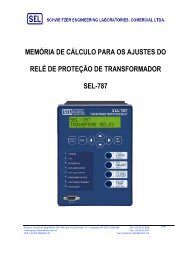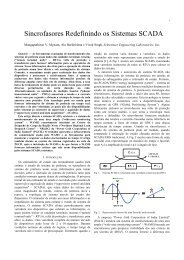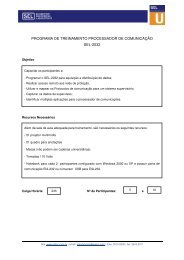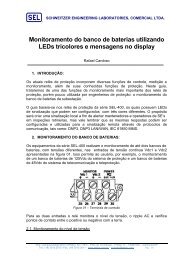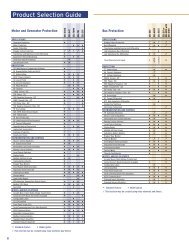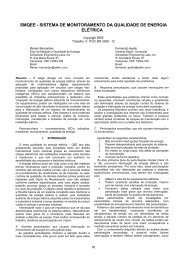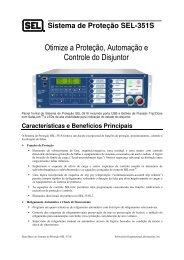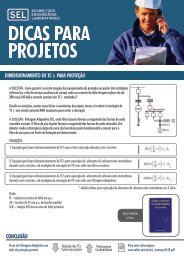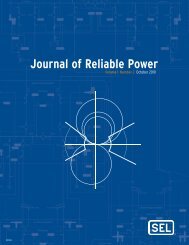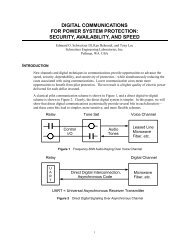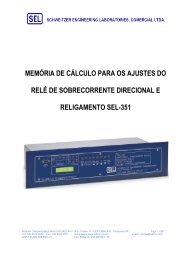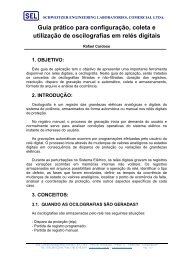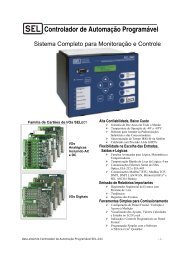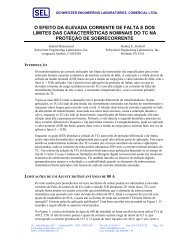Journal of Reliable Power - SEL
Journal of Reliable Power - SEL
Journal of Reliable Power - SEL
You also want an ePaper? Increase the reach of your titles
YUMPU automatically turns print PDFs into web optimized ePapers that Google loves.
The relay then performs “torque” calculations to determine<br />
which fault appears to be “closer” to the relay to decide<br />
between the two loops (C-G or A-B-G). For this case, the<br />
“torque” calculation showed the A-B-G as being closest. Thus,<br />
the relay selected the wrong loop.<br />
Improved relay designs (intended for single-pole or threepole<br />
applications) have better fault-type selection. These<br />
designs measure the fault resistance between phases and<br />
phase-to-ground. These would have correctly identified the<br />
fault type.<br />
Still, this example demonstrates the need for correct fault<br />
type selection. Knowing that the fault was C-G or A-B-G, we<br />
calculated the actual fault location to be 6.8 miles for the C-<br />
phase-to-ground fault (calculations from the event report data<br />
using the one-ended modified Takagi method):<br />
Calculated Fault Locations:<br />
C-G: 6.8 A-B-G: –137<br />
Conclusions for Example 2:<br />
1. Fault was C-phase-to-ground, one-ended location<br />
6.8 miles. (later confirmed from field reports).<br />
2. Weak source conditions challenge the one-ended<br />
fault locators for two reasons: nonhomogeneous<br />
system is more likely; fault type selection more<br />
difficult.<br />
3. Superior fault type selection would have provided<br />
the correct fault type and fault location.<br />
4. Two-ended negative-sequence impedance fault<br />
location would have correctly selected fault<br />
location for faults all along the line. (fault type<br />
selection not needed)<br />
C. Example 3: 345 kV Line Failed Insulator<br />
The line data for the transmission line:<br />
• Circuit 345-LINE is a 39.26 mile long, double-circuit<br />
345 kV line between terminals E and F.<br />
• 345-LINE circuit fault data:<br />
− 345-LINE E SUB <strong>SEL</strong>-311C 08-19-03.txt<br />
− 345-LINE F SUB <strong>SEL</strong>-311C 08-19-03.txt<br />
• 345-LINE – “A failed insulator strut was found on<br />
structure # 483, at about 6 miles from the F<br />
termination. Total line length is 39.26 miles.” Note –<br />
the line length setting in the relays is 39.30 miles.<br />
Figure 15 shows a one-line and event report screen<br />
captures.<br />
IA IB IC<br />
VA VB VC<br />
Figure 15<br />
5000<br />
2500<br />
0<br />
-2500<br />
-5000<br />
200<br />
100<br />
0<br />
-100<br />
-200<br />
E<br />
15000<br />
10000<br />
5000<br />
0<br />
-5000<br />
-10000<br />
-15000<br />
200<br />
IA IB IC<br />
VA VB VC<br />
100<br />
B-G<br />
28.55 mi<br />
Reported<br />
33.26 mi from E<br />
6.0 mi from F<br />
Actual<br />
345-Line 39.26 mi<br />
B-G<br />
6.29 mi<br />
Reported<br />
Example 3: One-Line and Event Report Screen Captures<br />
In Figure 16, the horizontal axis is the number <strong>of</strong> cycles<br />
and the vertical axis is the two-ended fault location averaged<br />
over several cycles. The actual fault location (33.26 miles) is<br />
about 0.85 per unit from the E terminal (depicted by a<br />
horizontal line on the graph). Note that the calculated fault<br />
locations are close to but do not exactly match the actual.<br />
1.5<br />
1.5<br />
m v<br />
ms v<br />
.85<br />
0<br />
-100<br />
-200<br />
1<br />
0.5<br />
IA IB IC VA VB VC<br />
2.5 5.0 7.5 10.0 12.5 15.0<br />
Cycles<br />
IA IB IC VA VB VC<br />
2.5 5.0 7.5 10.0 12.5 15.0<br />
Cycles<br />
Actual FL<br />
Calculated<br />
Two-Ended FL<br />
F<br />
0.0<br />
0<br />
0 2 4 6 8<br />
0 v<br />
RS<br />
8<br />
Figure 16 Example 3: Mathcad Screen Capture—Actual Fault Location<br />
versus Two-Ended Estimate<br />
Conclusions for Example 3:<br />
1. The system was slightly nonhomogeneous, which<br />
contributed to the poor local one-ended fault<br />
location estimate and the remote end being more<br />
accurate.<br />
Impedance-Based Fault Location Experience | 21



